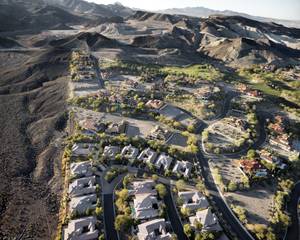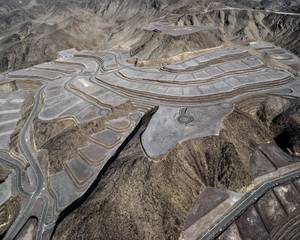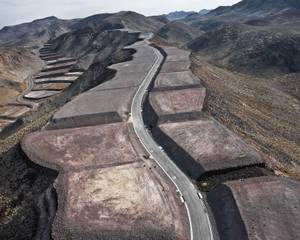Just when it had seemed that life couldn’t get any more bizarre in the Las Vegas Valley, someone built a 320-acre artificial lake on top of a wash and created a Tuscan/Mediterranean pop-up community. It was an effort so far removed from the reality of the Mojave Desert that for some of us living here it became another laughable element added to the punch line that is Las Vegas.
Though plans for Lake Las Vegas had been carved out in the late 1960s, it wasn’t until the arrival of houses and casinos in the late ’90s and early 2000s that praise and admonishment were thrown at the project that confirmed the permeation of the Strip’s European themes into the rest of the Valley—all in the name of the luxurious, attainable dream. But the housing bubble engulfing the Valley burst, Lake Las Vegas filed for bankruptcy and homes there were abandoned. Black Mountain—blasted away, leveled and scraped to insert the luxury community Ascaya—was left with nothing to cover its scars.
It was during this halted construction that San Francisco-based photographer Michael Light—whose interest is in American culture’s relationship to the landscape—began taking aerial images of the area, illustrating through these communities the “aspiration and collapse” of the American Dream.
Shot mostly from a helicopter (occasionally a small fixed-wing plane) Light’s work is among the most compelling and awe-inducing visual representations speaking to the audacity of the Valley’s famous building boom. The images, published in Light’s Lake Las Vegas/Black Mountain, are accompanied by essays written by Rebecca Solnit and Lucy Lippard. Light doesn’t offer his own commentary because, as he explains, the pictures “do the heavy lifting here.” The unfinished Ascaya, carved into the already harsh landscape, looks much like an abandoned space station on another planet in the large-scale, hardbound book (10.5 by 16.5 inches) with color images. Terracing, extracting and removing topsoil made for an easy comparison to mining communities.
And Light’s vantage point over Lake Las Vegas, combined with his experienced eye, allows for a broader view, highlighting the sudden and abrupt extravagance in an environment of limited resources, while emphasizing the very fine line between fiction and reality. Here, the little mansions are placed within the gouged and altered landscape, decorated to give the illusion of elsewhere, and accented by lumpy green golf courses where blankets of sod and pine trees speak an entirely different language than the host environment.
The lighting—early morning and late afternoon—enhances the dimensions of the subjects on the landscape, adding a physical depth.
We may grimace at the idea of limiting all of Las Vegas to the negative perspective of corporate sprawl and excess, but there’s no telling the whole story without it. And Light has echoed the sentiment that Las Vegas is not so much an isolated entity, but a representation of America. Here, that story is told through images that are as disturbing as they are beautiful.
Michael Light: Lake Las Vegas/Black Mountain Radiusbooks.org, $60










